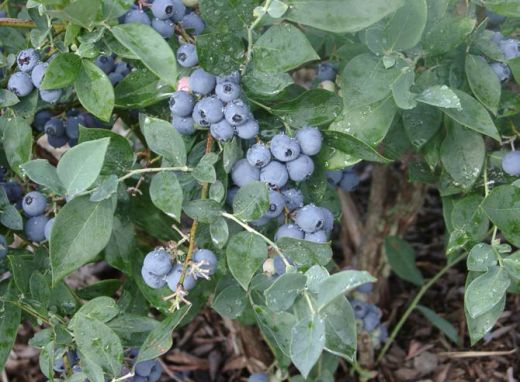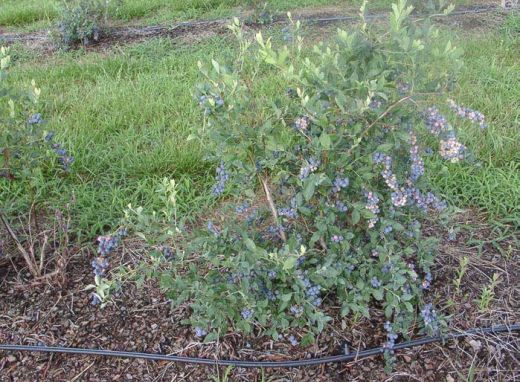At a Glance
Named for the Alapaha (a-LAP-uh-ha) River in southern Georgia, the Alapaha blueberry is a vigorous, upright plant with quite narrow crowns. Its characteristics include late flowering (7 to 10 days after the older variety Climax) with early ripening that produces consistently high yields of excellent quality fruit. The variety flowers relatively late (7 to 10 days after the older variety Climax), which helps avoidance of spring freeze damage.
Fruit
Berries are medium size and have excellent firmness, color and flavor. Their small dry scars contribute to good shelf life. Alapaha fruit ripens quickly, beginning about the same time as the Climax cultivar. Alapaha is recommended as an early ripening cultivar to replace Climax wherever rabbiteye blueberries are grown successfully. A four-year study in Georgia and Arkansas showed that Alapaha productivity substantially exceeded that of Climax every year.
Cultivation
The variety is suitable for mechanical harvesting and has demonstrated improved resistance to rain cracking. Alapaha is recommended for areas where rabbiteye blueberries are grown successfully as an early ripening variety to replace Climax. Alapaha has shown some self-pollination, but it should be planted with other rabbiteye blueberries with a similar time of bloom for cross pollination. Recommended companion variety is Vernon.
Development
Developed by D. Scott NeSmith of the University of Georgia, Alapaha is a joint release by the University of Georgia College of Agricultural and Environmental Sciences and the U.S. Department of Agriculture/Agricultural Research Service. This protected blueberry variety can be sold only by individuals licensed by the University of Georgia Research Foundation (UGARF) and Georgia Seed Development (GSD). USPP 16,266.
Breeder

D. Scott NeSmith
Dr. D. Scott NeSmith’s blueberry research program at the University of Georgia emphasizes new variety development as well as cultural management of blueberries for the southeastern United States.
Since taking over the UGA blueberry breeding program in 1998, Dr. NeSmith has released and patented 10 new commercial blueberry varieties and two ornamental blueberry varieties. His breeding program is now considered one of the most active low- to-mid chill blueberry programs in the world. He joined UGA in 1990.
Dr. NeSmith has expanded UGA’s program globally through collaborative projects throughout the U.S. and many other countries including South Africa, Argentina, Chile, Uruguay, Japan, Europe, Morocco, Australia, New Zealand, South Korea, Peru, and Mexico. Much of his cultural management research has been with growth regulators in blueberries. He also conducts experiments on plant establishment, pollination, and post-harvest quality.
Dr. NeSmith is a member of the American Society for Horticultural Sciences (ASHS) and the International Society for Horticultural Sciences. He is a past President of the Southern Region ASHS and has served as an Associate Editor for the ASHS journal, HortScience.
Dr. NeSmith has received the D.W. Brooks Excellence in Research Award from UGA and in 2011 was selected as a Fellow of the American Society for Horticultural Sciences. He has published more than 250 research papers, including more than 97 in refereed journals, and has received two awards for outstanding publications.
He graduated from the University of Georgia with B.S. and M.S. degrees. He obtained his Ph.D. from Michigan State University.
Affiliations
- Department of Horticulture
- University of Georgia, Griffin Campus


